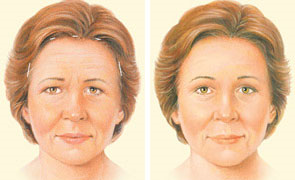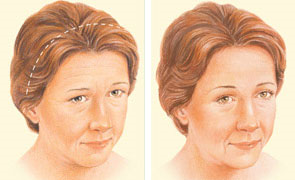What is a brow lift?
A brow lift, also known as a forehead lift:
- Reduces the wrinkle lines that develop horizontally across the forehead, as well as those that occur on the bridge of the nose, between the eyes
- Improves frown lines, the vertical creases that develop between the eyebrows
- Raises sagging brows that are hooding the upper eyelids
- Places the eyebrows in an alert and youthful position
Other cosmetic procedures that may be performed with a brow lift include:
Brow lift candidates
You may be a candidate for brow lift surgery if you:
- Are physically healthy
- Nonsmoker
- Have a positive outlook and realistic goals
As we age, unsightly wrinkle lines may appear on the forehead. Frown lines between the brows can make us look angry or "too serious." Skin relaxation may cause the eyebrows to drop, hooding our upper eyelids and making us look tired. If you are bothered by these signs of aging in the brow region, a brow lift may be right for you.
Brow lift recovery
During your brow lift recovery, your forehead may be taped and/or your head may be loosely wrapped to minimize swelling and bruising after the procedure is completed.
A thin tube may be present to drain any excess blood or fluid that may collect under the skin.
You will be given specific instructions that may include:
- How to care for the surgical site and drains
- Medications to apply or take orally
- Specific concerns to look for at the surgical site or in your general health
- When to follow up with your plastic surgeon.
You should keep your head elevated and perform no vigorous physical activity for as long as your surgeon recommends. Do not use ice or heat on the operated area.
Be sure to ask your plastic surgeon specific questions about what to expect during your recovery period.
- What medication will I need after surgery?
- Will I have dressings/bandages?
- When will they be removed?
- Are stitches removed? When?
- When can I resume normal activity and exercise?
- When do I return for follow-up care?
Brow lift surgery recovery time
Initial wound healing may take 10 to 14 days. Sutures or clips will be removed when it is appropriate. You should be ready to return to work and normal activity after 10-14 days.
Cosmetics can help camouflage any bruising.
Even though you will look presentable to the public, you will find that the healing will continue for several weeks, as the swelling dissipates and incision lines refine and fade. It may take several months for your complete recovery.
Following your physician's instructions is essential to the success of your surgery.
It's important that the surgical incisions are not subjected to excessive force, swelling, abrasion or motion during the time of healing. Your doctor will give you specific instructions on how to care for yourself.
Brow lift results
The results of your brow lift surgery are immediately visible. Over time, post-surgical swelling will resolve and incision lines will fade.
Satisfaction with your new image should continue to grow as you recover from surgery. The final results of your surgery will appear over the next few months.
Although good results are expected from your procedure, there can be no guarantee. Life-long sun protection will help to maintain your rejuvenated appearance by minimizing sun damage. A healthy lifestyle will also help extend the results of your surgery.
Brow lift procedure steps
Step 1 – Anesthesia
You will be given anesthesia so that you will be comfortable during the surgical procedures. Your surgeon will suggest either intravenous sedation or general anesthesia.
Step 2 – The incision
Brow lifts can be performed in different ways. Some surgeons prefer using an endoscope (a thin tube with a camera on the end) and special instruments placed through small incisions made within the hairline. This allows the tissue and muscle beneath the skin to be adjusted, correcting the source of visible creases and furrows in the forehead.
Endoscopic incision

Some surgeons prefer to perform a browlift through what is called a "coronal incision" The coronal incision is created from ear to ear across the top of the head within the hair-bearing skin.
The forehead skin is then lifted and any muscle adjustment can be made under direct visualization. The resulting scar from a coronal brow lift is well concealed within the hair.
Coronal incision

For women with very high foreheads, an incision just at the anterior hairline may be recommended. In this way the brow can be lifted without altering the height of the front hairline. The resulting scar, while somewhat more visible, can often be hidden with bangs.
Step 3 – Closing the incisions
Brow lift incisions typically are closed with:
- Removable or absorbable sutures
- Skin adhesives
- Special clips
Step 4 – See the results
Results appear within a few weeks as swelling and bruising subside to reveal smoother forehead skin and a more youthful, rested appearance. Get more information about brow lift results.
Brow lift risks and safety
The decision to have plastic surgery is extremely personal. You will have to decide if the surgery will achieve your goals and if the risks and potential complications of a brow lift are acceptable.
You will be asked to sign consent forms to ensure that you fully understand the procedure and any risks and potential complications.
Brow lift surgery risks include:
- Anesthesia risks
- Bleeding
- Loss of hair around the incisions
- Elevated hairline
- Eye irritation or dryness
- Facial asymmetry
- Facial nerve injury with weakness or paralysis
- Fluid accumulation
- Infection
- Numbness or other changes in skin sensation or intense itching
- Pain, which may persist
- Poor wound healing
- Possibility of revision surgery
- Skin loss
- Unfavorable scarring
- Rare risk of deep venous thrombosis (blood clots) that can result in pulmonary embolism with chest pain, shortness of breath
These risks and others will be fully discussed prior to your consent. It's important that you address all your questions directly with your plastic surgeon.
Your brow lift consultation
During your brow lift consultation be prepared to discuss:
- Your goals for your appearance
- Your complete medical history
- Your current prescription medications, including vitamins, herbal supplements, alcohol, tobacco and drug use
Your brow lift surgeon will also:
- Evaluate your general health status and any risk factors
- Discuss your options
- Examine and measure different parts of your face
- Take photographs
- Recommend a course of treatment
- Discuss likely outcomes of brow lift surgery and any potential complications
Be sure to ask questions. To help, we have prepared a checklist of questions to ask your brow lift surgeonthat you can take with you to your consultation.
It's very important to understand all aspects of your arm lift procedure. It's natural to feel some anxiety, whether it's excitement for your anticipated new look or a bit of preoperative stress. Don't be shy about discussing these feelings with your plastic surgeon.
Preparing for brow lift surgery
In preparing for brow lift surgery, you may be asked to:
- Get lab testing or a medical evaluation
- Take certain medications or adjust your current medications
- Stop smoking
- Avoid taking aspirin, anti-inflammatory drugs and other supplements as they can increase bleeding and bruising
Brow lift surgery should be performed in an accredited surgical facility, a licensed ambulatory surgical center or a hospital.
You will need to arrange for a friend or family member to drive you to and from surgery, and to stay with you the first night following surgery to assure your safety.